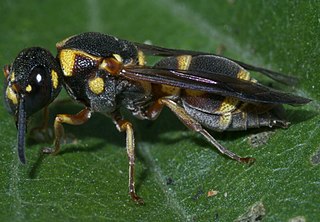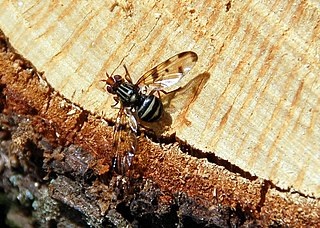
The Ulidiidae or picture-winged flies are a large and diverse cosmopolitan family of flies (Diptera), and as in related families, most species are herbivorous or detritivorous. They are often known as picture-winged flies, along with members of other families in the superfamily Tephritoidea that have patterns of bands or spots on the wings. Some species share with the Tephritidae an unusual elongated posteroapical projection of the anal cell in the wing, but can be differentiated by the smoothly curving subcostal vein. Two species, Tetanops myopaeformis and Euxesta stigmatias, are agricultural pests.

Pepsis is a genus of spider wasps belonging to the family Pompilidae. Species within this genus are also called tarantula hawks, as they usually hunt tarantulas, similarly to many species in the genus Hemipepsis. These wasps are restricted to the Americas, with the related genus Hemipepsis occurring in both Old and New Worlds.

Monobia is a primarily neotropical genus of medium-sized to large potter wasps occurring from the United States to Argentina. This genus is very closely related to the genus Montezumia. It contains the following species:
Hypancistrocerus is a rather small neotropical genus of potter wasps which is very close to the Genus Stenodynerus. The species included in the genus are:

Hypodynerus is a South American, primarily Andean, genus of potter wasps with most of its described species inhabiting Chile.
Discoelius is a palearctic genus of potter wasps with seven currently known species. It contains the following species:
Masarygus is a genus of hoverflies native to Argentina, containing two species. It was first described as representing a new family related to Conopidae or possibly the Oestridae due to its much reduced mouthparts. Larvae are found in ant nests.

Stenodynerus is a rather large genus of potter wasps whose distribution spans the Nearctic, Palearctic, Oriental and Neotropical regions. Most of its species lack a transverse carina on the first metasomal tergum. A pair of medial pits on the anterior face of the pronotum and the expansion of the tegulae put this genus close to genera as Parancistrocerus, Hypancistrocerus and Eustenancistrocerus.

Xenos is a genus of insects belonging to the family Xenidae. The word derives from the Greek word for strange. A species of the genus is Xenos vesparum, first described by Pietro Rossi in 1793. The females are permanent entomophagous endoparasites of Polistes paper wasps. They dwell their whole lives in the abdomens of wasps.

Otitinae is the name of a subfamily of flies in the family Ulidiidae. It was formerly the Otitidae. Like the Ulidiinae, most species are herbivorous or saprophagous. Most species share with the Tephritidae an unusual elongated projection of the anal cell in the wing, but can be differentiated by the smoothly curving subcostal vein. Most are dull gray to shiny brown or black flies with vein R1 setulose or, in a few cases, bare.
Cactoblastis ronnai is a species of snout moth in the genus Cactoblastis. It was described by Juan Brèthes in 1920 and is known from Brazil.

Linepithema is a genus of small ants in the subfamily Dolichoderinae.

Diadasia is a genus of bees in the family Apidae. Its species are oligolectic, specialized on a relatively small number of plant species.
Cyphomenes anisitsii is a species of insect in the genus Cyphomenes and the family Eumenidae native to Mexico, Guatemala, and Venezuela first described by Juan Brèthes in 1906. As of 2018, one subspecies is listed in the Catalogue of Life, Cyphomenes anisitsii ornatissmus.
Epinysson is a genus of kleptoparasitic wasps in the family Bembicidae. There are more than 20 described species in Epinysson.
Astrophanes is a genus of bee flies in the family Bombyliidae. There are two described species in the genus.
Pseneo is a genus of aphid wasps in the family Psenidae. There are more than 20 described species in Pseneo.

Evania is a genus of ensign wasps in the family Evaniidae. Like all members of the family, they are cockroach egg parasitoids. There are more than 60 described species in Evania. Evania appendigaster, the blue-eyed ensign wasp, is a common wasp found through most of the world.
Oxyaporia is a genus of parasitic flies in the family Tachinidae.










